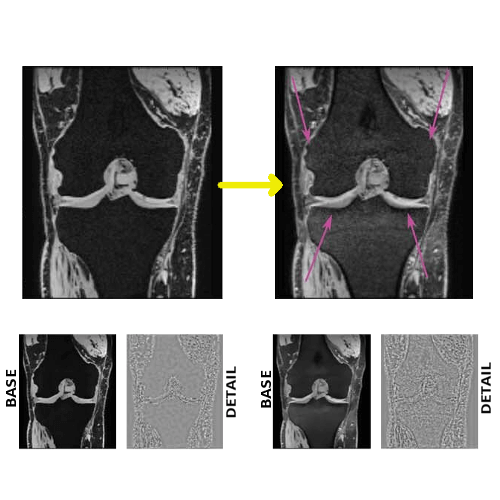Application
The high dynamic range image processing algorithm can offer enhanced contrast and feature preservation for multichannel and multisequence MR images.
Contributors
Shekhar S. Chandra1, Craig Engstrom3, Jurgen Fripp1,4, Ales Neubert4, Jin Jin1, Duncan Walker5, Olivier Salvado1,4, Charles Ho2, Stuart Crozier1
Estimated cost
Free
Progress
Stable release, Apache License v2.0
High dynamic range (HDR) offers the significant capacity to nonlinearly adjust the final contrast. This provides the capability to emphasize or diminish contrast based on the available data, while preserving all possible features within a single image.
The goal of the HDR-MRI approach is to achieve automated local contrast enhancement of tissues/anatomy by adjusting the contrast across small regions of the image based on local details from multiple low dynamic range images. Thus, the HDR-MRI approach preserves all of the fine details in multichannel and/or multisequence MR data.
This work presents an image-processing approach to fuse 3D imaging information from different MR sequences that both preserves the image information and dynamically increases contrast for enhanced anatomical visualization in a single (unified) MR image. The proposed 3D HDR-MRI scheme is applicable to multichannel 3D MR data as well as multisequence 3D data sets. This makes it ideally suited for use in imaging studies across an array of established MR sequences.
The proposed scheme has 3 main steps:
- It creates a multi-light image collection by separating the fine details from large-scale structures by repeatedly over-smoothing the input multichannel MR images. This is accomplished by applying a fast variant of the bilateral filter to the smallest scale to each multichannel MR image, and computing the difference with the original MR image. This generates a series of difference images and base (i.e., smoothed) images for that scale for each multichannel MR image. The process is repeated for the next scale on the results of the previous scale, which generates more difference images for this scale. This continues until completion of the prescribed number of levels. Because the bilateral filter is nonlinear, smoothing at subsequent scales provides additional fine detail information for that scale than if smoothing the original image directly at that scale.
- Multiscale shape detail enhancement is computed by combining the details and the base images at all scales. The intensities of the details are rescaled to compensate for strong edges that might (re)occur at multiple scales, as the bilateral filter is imperfect. The details are then combined by up-scaling weak signals and by using the robust maximum among the multichannel MR images per corresponding voxels.
- The base is recomposed with a weighted combined detail image to produce the final synthesized HDR-MRI.
The successful combination of multichannel/sequence MR images into a single-fused HDR-MR image format provided consolidated visualization of tissues within 1 omnibus image, enhanced definition of thin, complex anatomical structures in the presence of variable or hyper-intense signals, and improved tissue (cartilage) segmentation outcomes.
Publications
Affiliations
1School of Information Technology and Electrical Engineering, University of Queensland, Brisbane, Australia;
2Steadman Philippon Research Institute (SPRI), Vail, Colorado;
3School of Human Movement Studies, University of Queensland, St Lucia, Australia;
4The Australian e-Health Research Centre, CSIRO Health and Biosecurity, Herston, Australia.


